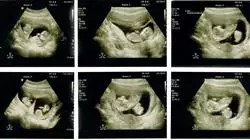University certificate
The world's largest faculty of nursing”
Introduction to the Program
This 100% online Postgraduate certificate will provide you with a solid update on the complications that can arise during the first trimester of pregnancy, identifying warning signs and providing effective care”

For nurses, caring for a pregnant woman with first trimester problems, including bleeding and malformations, requires a delicate and meticulous approach. Therefore, frequent assessments of the patient's condition and close monitoring of any signs of complications are essential, as well as providing sympathetic emotional support to the patient and her family.
This is how this Postgraduate certificate was born, which will provide a comprehensive understanding of the most common hemorrhagic pathologies during this critical period, including miscarriage, molas and ectopic pregnancy. Nurses will gain a solid understanding of the underlying causes and the most effective therapeutic approaches to address these complications.
In addition, a comprehensive update will be provided on the most advanced protocols for addressing suspected fetal malformations, using state-of-the-art technologies. Professionals will also be able to interpret results effectively, enabling them to work together with the medical team, offering comprehensive and personalized care to pregnant women and their babies.
Finally, they will deepen their knowledge of infectious diseases that can cause congenital defects in the fetus, allowing graduates to implement preventive strategies in their daily healthcare practice. In addition, the management of pregnancies with sociodemographic risk, such as adolescent pregnancies, will be analyzed, providing the necessary tools to approach these situations with scientific rigor and empathy, guaranteeing optimal care for all pregnant women, regardless of their socio-cultural context.
For this reason, TECH has created a complete and digital educational program, which allows students to access teaching resources using an electronic device connected to the Internet. This proposal is based on the principle of Relearning, which promotes the continuous repetition of essential concepts to improve the understanding of the study materials. With the objective of bringing them knowledge and procedures that are applied in different parts of the world, in this program they will get Masterclasses given by two prestigious International Guest Directors.
Learn first-hand about the best practices for nurses in the Obstetrics area thanks to the Masterclasses given by two International Guest Directors. Get updated from the experts!”
This Postgraduate certificate in Pregnancy with First Trimester Problems: Bleeding and Malformations for Nursing contains the most complete and up-to-date scientific program on the market. The most important features include:
- The development of case studies presented by experts in Pregnancy with First Trimester Problems: Bleeding and Malformations for Nursing
- The graphic, schematic and eminently practical contents with which it is conceived gather scientific and practical information on those disciplines that are indispensable for professional practice
- Practical exercises where the self-assessment process can be carried out to improve learning
- Its special emphasis on innovative methodologies
- Theoretical lessons, questions to the expert, debate forums on controversial topics, and individual reflection assignments
- Content that is accessible from any fixed or portable device with an Internet connection
You will be immersed in the management of gestations with sociodemographic risk, such as adolescent gestations, with a rigorous and scientific approach, all through state-of-the-art didactic materials”
The program’s teaching staff includes professionals from the field who contribute their work experience to this educational program, as well as renowned specialists from leading societies and prestigious universities.
The multimedia content, developed with the latest educational technology, will provide the professional with situated and contextual learning, i.e., a simulated environment that will provide immersive education programmed to learn in real situations.
This program is designed around Problem-Based Learning, whereby the professional must try to solve the different professional practice situations that arise during the course. For this purpose, students will be assisted by an innovative interactive video system created by renowned and experienced experts.
This university program will ensure that you are prepared to provide a rapid and accurate response to emergency situations, thereby improving the care and safety of patients and fetuses"

You will master the most advanced tools and techniques available today, as well as the multidisciplinary approaches needed to ensure comprehensive, patient-centered care"
Why study at TECH?
TECH is the world’s largest online university. With an impressive catalog of more than 14,000 university programs available in 11 languages, it is positioned as a leader in employability, with a 99% job placement rate. In addition, it relies on an enormous faculty of more than 6,000 professors of the highest international renown.

Study at the world's largest online university and guarantee your professional success. The future starts at TECH”
The world’s best online university according to FORBES
The prestigious Forbes magazine, specialized in business and finance, has highlighted TECH as “the world's best online university” This is what they have recently stated in an article in their digital edition in which they echo the success story of this institution, “thanks to the academic offer it provides, the selection of its teaching staff, and an innovative learning method aimed at educating the professionals of the future”
A revolutionary study method, a cutting-edge faculty and a practical focus: the key to TECH's success.
The most complete study plans on the university scene
TECH offers the most complete study plans on the university scene, with syllabuses that cover fundamental concepts and, at the same time, the main scientific advances in their specific scientific areas. In addition, these programs are continuously being updated to guarantee students the academic vanguard and the most in-demand professional skills. In this way, the university's qualifications provide its graduates with a significant advantage to propel their careers to success.
TECH offers the most comprehensive and intensive study plans on the current university scene.
A world-class teaching staff
TECH's teaching staff is made up of more than 6,000 professors with the highest international recognition. Professors, researchers and top executives of multinational companies, including Isaiah Covington, performance coach of the Boston Celtics; Magda Romanska, principal investigator at Harvard MetaLAB; Ignacio Wistumba, chairman of the department of translational molecular pathology at MD Anderson Cancer Center; and D.W. Pine, creative director of TIME magazine, among others.
Internationally renowned experts, specialized in different branches of Health, Technology, Communication and Business, form part of the TECH faculty.
A unique learning method
TECH is the first university to use Relearning in all its programs. It is the best online learning methodology, accredited with international teaching quality certifications, provided by prestigious educational agencies. In addition, this disruptive educational model is complemented with the “Case Method”, thereby setting up a unique online teaching strategy. Innovative teaching resources are also implemented, including detailed videos, infographics and interactive summaries.
TECH combines Relearning and the Case Method in all its university programs to guarantee excellent theoretical and practical learning, studying whenever and wherever you want.
The world's largest online university
TECH is the world’s largest online university. We are the largest educational institution, with the best and widest online educational catalog, one hundred percent online and covering the vast majority of areas of knowledge. We offer a large selection of our own degrees and accredited online undergraduate and postgraduate degrees. In total, more than 14,000 university degrees, in eleven different languages, make us the largest educational largest in the world.
TECH has the world's most extensive catalog of academic and official programs, available in more than 11 languages.
Google Premier Partner
The American technology giant has awarded TECH the Google Google Premier Partner badge. This award, which is only available to 3% of the world's companies, highlights the efficient, flexible and tailored experience that this university provides to students. The recognition as a Google Premier Partner not only accredits the maximum rigor, performance and investment in TECH's digital infrastructures, but also places this university as one of the world's leading technology companies.
Google has positioned TECH in the top 3% of the world's most important technology companies by awarding it its Google Premier Partner badge.
The official online university of the NBA
TECH is the official online university of the NBA. Thanks to our agreement with the biggest league in basketball, we offer our students exclusive university programs, as well as a wide variety of educational resources focused on the business of the league and other areas of the sports industry. Each program is made up of a uniquely designed syllabus and features exceptional guest hosts: professionals with a distinguished sports background who will offer their expertise on the most relevant topics.
TECH has been selected by the NBA, the world's top basketball league, as its official online university.
The top-rated university by its students
Students have positioned TECH as the world's top-rated university on the main review websites, with a highest rating of 4.9 out of 5, obtained from more than 1,000 reviews. These results consolidate TECH as the benchmark university institution at an international level, reflecting the excellence and positive impact of its educational model.” reflecting the excellence and positive impact of its educational model.”
TECH is the world’s top-rated university by its students.
Leaders in employability
TECH has managed to become the leading university in employability. 99% of its students obtain jobs in the academic field they have studied, within one year of completing any of the university's programs. A similar number achieve immediate career enhancement. All this thanks to a study methodology that bases its effectiveness on the acquisition of practical skills, which are absolutely necessary for professional development.
99% of TECH graduates find a job within a year of completing their studies.
Postgraduate Certificate in Pregnancy with First Trimester Problems: Bleeding and Malformations for Nursing
In the field of nursing it is essential to be up to date in the pathology related to the first trimester of pregnancy. Therefore, this Postgraduate Certificate in Pregnancy with First Trimester Problems: Bleeding and Malformations for Nursing offers a complete education in this field, so that health professionals are prepared to care for pregnant patients with problems in the first months of conception. The first trimester of pregnancy is a crucial stage in fetal development, when problems such as bleeding and malformations can occur. For this reason, it is important that healthcare professionals are prepared to deal with these cases and provide quality care to patients.
Get up-to-date on the complexities of pregnancy
This course will address in a rigorous and practical way topics such as the causes of fetal malformations and their clinical management, as well as the identification and treatment of bleeding during the first trimester of pregnancy. All this, with the objective of providing nursing professionals with the necessary tools to perform an adequate and timely intervention in emergency cases. The continuous evolution of medicine in the field of fetal malformations and problems in the first trimester of pregnancy makes the updating of knowledge essential in this field. The course is designed to provide students with complete and up to date education on this subject, so that they can apply the knowledge acquired in their healthcare work and improve the quality of care for pregnant patients. In addition, its 100% online modality allows students to adapt their learning to their own pace and schedules, without the need for travel or interruptions in their daily work.







